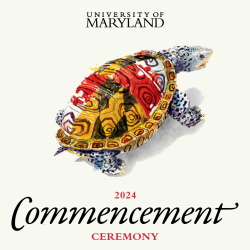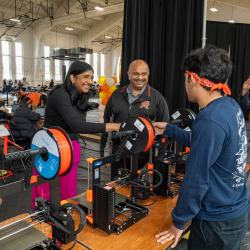Computer Science Receives $38.7 Million in Gifts
 A record $31 million gift from a former University of Maryland student will help create a new home for the Department of Computer Science—and raise its stature as a global leader in virtual reality, robotics, computer vision and immersive science.
A record $31 million gift from a former University of Maryland student will help create a new home for the Department of Computer Science—and raise its stature as a global leader in virtual reality, robotics, computer vision and immersive science.
The Brendan Iribe Center for Computer Science and Innovation, named for the Oculus VR co-founder and CEO who made the largest single gift in university history, will be a place where students and faculty members from across campus can come together to learn, create and discover.
Oculus Co-founder and Chief Software Architect Michael Antonov, B.S. ’03, computer science, who has worked alongside Iribe since their days at UMD, is giving $4 million for the building project and scholarships, and Iribe’s mother, Elizabeth, is contributing $3 million for two endowed professorships in computer science. Thirty-two computer science faculty members have personally committed over $733,000 to help fund the building.
“The innovation and entrepreneurship that will be sparked in the Iribe Center will be an economic engine for our state and nation,” says Jayanth Banavar, dean of the College of Computer, Mathematical, and Natural Sciences.
Iribe, who studied at UMD in 1997-98 before beginning his career as a serial entrepreneur, first suggested creating—and funding—the building only 10 days after Facebook announced in March that it would acquire Oculus for approximately $2 billion.
“I’m making this investment now because it gives me the opportunity to participate alongside the students and help them in any way I can to create amazing things,” says Iribe. “I don’t want to just be a name on a building. I want to be someone who continues to show up on campus and inspires student exploration and entrepreneurship for years to come.”
The new facility, which will be located adjacent to the Computer Science Instructional Center at the main entrance to campus, will emphasize communal meeting spaces, community areas and hands-on learning. It will include “maker spaces” and “hacker spaces” with equipment and tools for students and faculty across campus to collaborate, experiment and bring their ideas to life.
 “Virtual reality enables your imagination to go wild,” says Antonov. “Having a facility at the University of Maryland that encourages and sparks this type of creativity will provide a unique experience for students.”
“Virtual reality enables your imagination to go wild,” says Antonov. “Having a facility at the University of Maryland that encourages and sparks this type of creativity will provide a unique experience for students.”
Students will have the opportunity to take courses in classrooms designed specifically for interactive and active learning. The building will also include specialized labs to support the expansion of research in areas such as virtual and augmented reality, computer vision, robotics and big data.
New research in these areas will enhance ongoing projects, like the “augmentarium” Amitabh Varshney, computer science professor and director of the university’s Institute for Advanced Computer Studies (UMIACS), is constructing with support from the National Science Foundation. The space will feature interactive projection displays, head-mounted displays, programmable robotic mounts and high-speed computing clusters that researchers will use to visualize large and complex data for a range of applications, including image-guided surgical interventions.
Computer Science Professor Ramani Duraiswami, who also has an appointment in UMIACS, is applying his research on how humans understand sound to create virtual reality environments in which users feel immersed in the sounds of another world. His College Park, Md.-based company VisiSonics recently announced that Oculus licensed its RealSpace3D audio technology to create high-fidelity virtual reality experiences for the Oculus Rift headset.
“Placing the University of Maryland at the center of virtual reality research with ties directly to Oculus will be amazing for the faculty and students who will be part of this new industry that will have a huge impact on the world,” says Iribe.
While virtual reality technology has its roots in video gaming, Iribe sees future virtual reality applications in medicine, travel, history, art, sports and more. In the new building, students—with majors ranging from engineering and art to business and behavioral science—and local community members will be invited to attend courses and events and use its space to pursue projects that could change the world.
The Iribe Center will help centralize computer science and UMIACS faculty members who are currently spread out among four buildings on campus, with A.V. Williams (a building designed in 1987 as generic office space) serving as home base. The new facility will also support the growing computer science department, where undergraduate enrollment has expanded from nearly 800 majors in 2009 to almost 1,400 in 2013, with more than 200 students pursuing graduate degrees. Recently, the 40-year-old department was named No. 17 in the Academic Ranking of World Universities and No. 15 in U.S. News & World Report’s rankings of graduate programs.
“Two of my goals in giving this donation are to raise the position of the university and attract many more top computer science students and faculty members,” says Iribe. “Right now, we’re top 15, but top 5 is better and No. 1 is best!”
Computer science students will also benefit from the new scholarships Iribe and Antonov are creating. Iribe pledged $1 million of his donation and Antonov gave $500,000 of his toward scholarships, which include a fund in memory of their longtime business partner Andrew Reisse, B.S. ’01, computer science, who passed away in 2013.
“The gift began after a tragedy and will end in a living memorial,” said UMD President Wallace Loh. “It demonstrates the impact of friendship, teamwork and family—qualities that ultimately benefit our students and faculty.”
Elizabeth Iribe’s named chairs will support the department chair of computer science and a yet-to-be-recruited faculty member who inspires students and conducts innovative research.
“I believe in public education, and I’m so glad Brendan and I are investing in the state of Maryland’s flagship institution,” says Elizabeth Iribe.
“The gifts from Brendan, Michael and Liz will completely transform computer science at Maryland. The impact will be felt by our students, faculty, staff and the state for decades to come,” says Samir Khuller, chair of the Department of Computer Science. “They will help us achieve greatness, move into new research areas and provide an unparalleled experience for students.”
Computer Science Professor Emeritus Bill Pugh, who is helping with the building’s fundraising effort and kicking in $500,000 of his own money, says more engagement from alumni and state officials is needed to fully realize a wonderful future for computer science at Maryland.
“The Iribe Center will significantly improve the research and educational impact of the computer science department and make us the top-ranked maker/hacker university in the world. The leadership gifts from Brendan and Michael and the important commitment of the faculty are a great start, but to fully realize that vision, we need to raise an additional $15 million from donors and $100 million from the state,” says Pugh.
Writer: Abby Robinson
See also:







